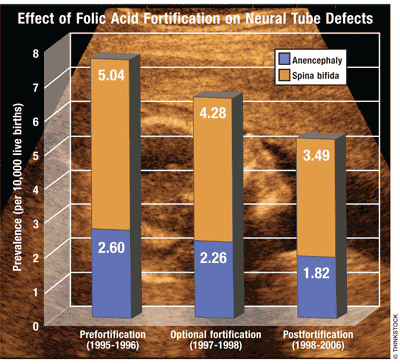US Pharm. 2011;36(1):11.
According to the CDC, defects of the spine (spina bifida [SB]) and brain (anencephaly) are common neural tube defects (NTDs). SB affects about one in every 33 babies born each year. Most NTDs develop during the first 3 months of pregnancy, affecting one of 1,000 pregnancies, or eight pregnancies per day. Babies born with NTDs are at greater risk for illness and long-term disability. Each of the 65 million women of childbearing age is theoretically at risk for having a pregnancy affected by NTDs, while 3,000 pregnancies may potentially be affected. Ninety-five percent of NTDs occur in women with no personal or family history of NTDs, but some risk factors are known.

Folic Acid Fortification: In 1992, the Public Health Service recommended that women of childbearing age consume 400 mcg of folic acid daily to help prevent the development of NTDs. Subsequently, the FDA mandated that folic acid be added to all enriched cereal-grain products by January 1998. Before food fortification, only 29% of reproductive-age women were taking folic acid.
From the early postfortification period (1999-2000) to the most recent period of analysis (2003-2005), the prevalence of SB declined 31%, from the prefortification (1995-1996) rate of 5.04 per 10,000 to the postfortification (1998-2006) rate of 3.49 per 10,000. During the same period, NTD prevalence dropped from 53.4 per 100,000 to 46.5 per 100,000 in women who received only third-trimester or no prenatal care. The 2009 medical cost for the first year of life of a child with SB was determined to be $52,415, while lifetime nonmedical and medical costs were estimated at $56,511 and $460,923, respectively.
Prevalence: The National Health and Nutrition Examination Survey found that Hispanic women had the highest rate (4.17 per 10,000) of bearing a child with NTDs, compared with non-Hispanic white women (3.22 per 10,000) and non-Hispanic black women (2.64 per 10,000). The prevalence of SB among children and adolescents aged 0 to 19 years was 3.1 cases per 10,000, representing about 24,860 children and adolescents. The prevalence of SB was highest in children aged 4 to 7 years, and was 14% higher in girls than in boys.
After a decline, the anencephaly rate was stable during the period 1994 to 1997, lower during 1998 to 2002 (9.97 for the period), and higher during 2003 to 2006 (10.96). The prevalence of anencephaly varied substantially with inclusion of elective terminations. The long-term downward trend in anencephaly prevalence that preceded fortification with folic acid makes it difficult to interpret the 11% decline postfortification.
To comment on this article, contact rdavidson@uspharmacist.com.





